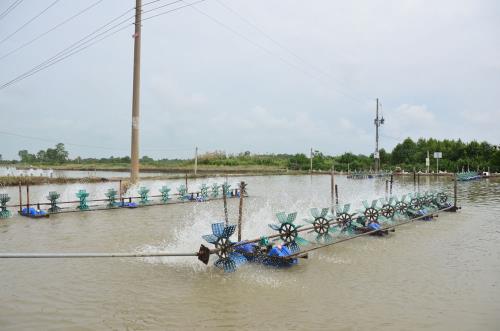 Society
Society


|
| Shrimp breeding in Sóc Trăng Province. — VNA/VNS Photo Mai Phương |
SÓC TRĂNG — The incomes of people living in coastal areas in the Cửu Long (Mekong) Delta province of Sóc Trăng have improved under the coastal resources for sustainable development project implemented since 2012, local authorities said.
Sóc Trăng is one of eight out of the country’s 28 coastal provinces and cities selected for the project managed by the Ministry of Agriculture and Rural Development.
The project’s components include institutional capacity building for sustainable fisheries management, good practices for sustainable aquaculture and sustainable management of nearshore capture fisheries.
In Sóc Trăng, it is being implemented in Trần Đề, Mỹ Xuyên and Cù Lao Dung districts and Vĩnh Châu Town. More than 12,700 farmers have been trained in Vietnamese good agricultural practices (VietGAP), exceeding the original target by 58 per cent, according to authorities.
Wastewater discharged by 76 per cent of farmers involved in aquaculture in the province meets national standards.
It has developed five GAP aquaculture areas covering a total area of 7,848ha and involving 5,095 households.
The project has established five fisheries groups and developed 110 effective livelihood models.
Besides exploiting fisheries resources, members of the fisheries groups are also trained in farming models like breeding mangrove clams in mangrove forests, ducks and both shrimp and tilapia in a single pond.
Most people in the province’s coastal areas are poor and relies mainly on fisheries for their livelihood.
Thiều Quang Đức, director of the project in Sóc Trăng, said it has helped significantly improve the incomes of local people.
Many models offer high incomes like extensive shrimp farming, semi-intensive shrimp farming, shrimp – rice farming, mud crab farming, and giant river prawn farming, he said.
The project has helped increase incomes by 20-30 per cent and reduce poverty, especially among ethnic minority households.
Aquaculturists participating in the project earn dozens of millions of đồng to VNĐ600 million (US$26,000) per hectare, higher than other farmers.
Lê Văn Hiểu, deputy chairman of the province People’s Committee, said: “The project has achieved good results and the Department of Agriculture and Rural Development should continue to expand [it].”
Besides efficiently and reasonably exploiting coastal resources, people should protect the environment and protective forests in coastal areas to create a good environment for sustainable coastal fisheries development, he said.
Sóc Trăng has a coastline of 72 kilometres and large inland water bodies which provide large and diverse fisheries resources. — VNS




